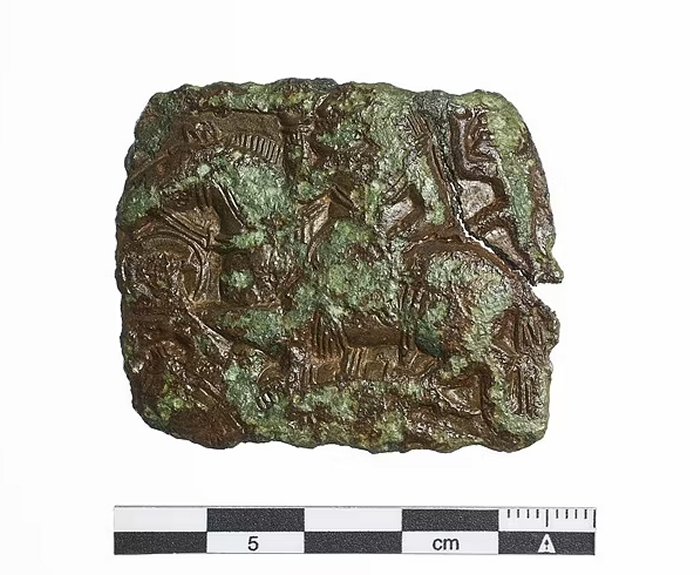Jan Bartek – AncientPages.com – The Sutton Hoo helmet, one of Great Britain’s most significant archaeological discoveries, is often likened to the ‘British Tutankhamun.’ Due to its motifs of mounted warriors, it was initially thought to originate from Uppland in Sweden, but recent findings suggest a different origin.
Two years ago, local archaeologist Jan Hjort discovered a green-tinged copper alloy stamp while using a metal detector in a field on the Danish island of Taasinge. The unearthed stamp closely resembles one of the helmet’s motifs, implying that the helmet may have been crafted in Denmark’s South Funen archipelago.
Replica of the helmet from the Sutton Hoo ship-burial 1, England. Credit: Gernot Keller – CC BY-SA 2.5
This new evidence could reshape our understanding of Northern Europe’s power dynamics in the 7th century, highlighting Denmark’s potentially pivotal role. At the start of this century, the Sutton Hoo helmet was interred in Southeast England as part of an elaborate ship burial and remained hidden until its excavation in 1939. Although found fragmented into hundreds of pieces, experts successfully reconstructed it, including its distinctive motif featuring a mounted warrior above a prone figure.
The recently discovered stamp from Tåsinge matches this motif and was identified as a ‘patrice’, used for imprinting designs onto metal sheets. After being handed over to Svendborg Museum, it was sent to Denmark’s National Museum for detailed study by curator Peter Pentz. This finding could significantly alter historical perspectives on both the origins of this iconic artifact and regional influences during that era.
Peter Pentz with the patrice from Tåsinge that can be connected with the Sutton Hoo helmet. Photo: John Fhær Engedal Nissen, The National Museum of Denmark.
When comparing the motif on the newly discovered patrice from Tåsinge to the mounted warrior depicted on the Sutton Hoo helmet and those found in Sweden, it becomes evident that the Tåsinge patrice bears a closer resemblance to the Sutton Hoo helmet than to Swedish motifs. This similarity is apparent in specific details such as the cuff at the warrior’s wrist, his hairstyle, and features like the almond-shaped harness fitting on the horse’s head, its reins, and a sword visible beneath his shield.
Additionally, there are ‘bunions’ or circles on the feet of a reclining figure. In contrast, Swedish motifs typically include elements like a wild boar or bird of prey on their helmets—features absent from both the Sutton Hoo helmet and this new discovery from Tåsinge.
According to Peter Pentz, curator at the National Museum of Denmark, this could mean the famous helmet is more likely to have been made in Denmark than in Sweden.
This small metal stamp was discovered on the island of Taasinge in southern Denmark. Researchers have noted that its design closely resembles that of the Sutton Hoo helmet. Credit: The National Museum of Denmark.
“The Sutton Hoo helmet is iconic worldwide. It is a national treasure for the British on a par with the chariot of the sun for Danes. It would be sensational if this helmet, obviously worn by someone of great importance, possibly a king, was made in Tåsinge.
It points to a possible Danish connection to the helmet, but also to the person who wore and was buried with it,” Pentz said in a press release.
The potential link between Tåsinge and Sutton Hoo is becoming increasingly significant. Beyond the initial motif of a mounted warrior, another similar depiction exists on the helmet. However, only a few fragments have been discovered, preventing a complete reconstruction.
Detailed analysis of these fragments reveals an even closer resemblance to the Tåsinge motif than to the fully reconstructed motif on the Sutton Hoo helmet. According to Peter Pentz, two details stand out prominently. The first is the lines near the horseman’s foot, which appear identically on both the stamp and fragment but are missing from other motifs. The second notable feature is the edge of the shield held by a reclining figure, which matches precisely between both sources.
The striking similarity between the fragmented motif and the patrice could mean that they might not only come from the same area but were also made by the same group of craftsmen. As Peter Pentz says:
“Despite being made in very different places, many motifs are clearly inspired by each other. But when the likeness is as strong as it is here, it could mean that they were not only made in the same place but even by the same craftsmen. That could provide strong evidence that the Sutton Hoo helmet was actually made in Tåsinge, which would make it an incredible find.”
A planned 3D scan of the Patrice and fragments can hopefully establish exactly how close the two are.
Was Denmark A Regional Superpower?
If the Sutton Hoo helmet were indeed crafted in or near Tåsinge, it would significantly alter previous perceptions of Denmark’s influence in Northern Europe’s power dynamics around the year 600. Historically, no burial sites as grand as those found in England and Sweden from this era have been discovered in Denmark, leading some to believe that the Danish region held little significance.
1939 excavation of Sutton Hoo burial ship. Image credit: Harold John Phillips – Public Domain
However, Peter Pentz suggests that this new discovery provides a stronger foundation for considering Denmark as a relatively powerful entity during this time, potentially even one of Northern Europe’s leading powers.
Some scholars have previously posited that England and Sweden might have served as outposts for a Danish power base in the 7th century. The iconic helmets and ship burials unearthed there could indicate a strong connection to Denmark as a central authority. The find at Tåsinge lends support to this theory but is not conclusive on its own. As Peter Pentz notes, an artifact like a small stamp measuring just 4.5 cm could have traveled extensively across regions.
See also: More Archaeology News
“It is still too early to draw any conclusions, but it does indicate that Denmark played a more important role during this period than previously assumed. We often attribute the uniting of the kingdom to Harald Bluetooth in the 10th century, but Denmark could have been relatively united and powerful as early as 600 CE. It is a find that challenges previous theories, and that is always exciting,” says Peter Pentz.
The stamp will be exhibited at the National Museum of Denmark from Tuesday, April 1.
Written by Jan Bartek – AncientPages.com Staff Writer












